Jessica Knauss's Blog, page 2
November 23, 2021
Happy 800th Birthday to the Wise King - Feliz 800�� cumplea��os al Rey Sabio

On November 23, 1221, a boy was born who would become Alfonso X, King of Castile and Le��n.
Even his political enemies couldn���t tarnish his legacy of intellectual curiosity and cultural open-mindedness.
I took the opportunity of Alfonso���s personal appearance in in Cantiga 321 to portray the empathetic and kind ruler I personally hope he was in Our Lady's Troubadour. (The excerpt is from "Clear Water." But more about that story in another post.)
Happy eight-hundredth birthday to the Wise King!
In honor of this extraordinary occasion, I'd like to share my translation of one of the most autobiographical Cantigas de Santa Maria.
Every tenth cantiga is a song of praise. These usually don't have plots, but do have more daring poetic and musical forms. Cantiga 200 is special among these special cantigas because here, Alfonso X himself uses the form of praise to present an autobiographical sketch of sorts. It's general, but it's told from an emotional point of view, unlike other, more specific such stories.
Cantiga 200
Refrain: I've praised, I praise, and I will keep praising St. Mary.
Because among all the most honored men alive today, she's shown me the most blessings, as I will recount.
She made me descend from good people and wanted me to fully rein and be king.
And with her mercies, she aided me in grave illnesses. Therefore, you must know that I will serve her.
And to those who wished me ill and conspired and plotted against me, she gave them what they deserved, as I will prove.
She pulled me out of great poverty and gave me riches, and so I will tell all her noble qualities that I can.
She who doesn't err and never erred made me the lord of a good land and helped me in every war when I called on her.
She delivered me from misfortune, death, and injury. So, know, good people, that I will die for her.
So everyone help me pray with good will for her to help me, since I have need.
And whenever she desires, that she will take me from the tumult of this world, and that I will see her whom I've always loved.
***
I believe and hope Alfonso X achieved what he's asking for in this personal poem.
Perhaps the greatest present we can give him on his birthday is the feat of remembering him 800 years later.
This is the main goal of Our Lady's Troubadour.
And, as Our Lady's Troubadour is available in both English and the Spanish Alfonso X did so much to create:
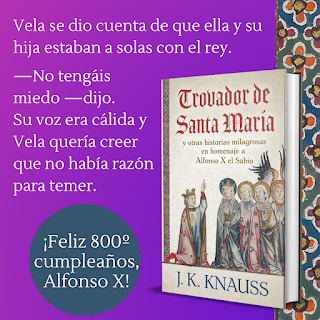
El 23 de noviembre de 1221, naci�� un ni��o que se convertir��a en Alfonso X, rey de Castilla y Le��n.
Ni siquiera sus enemigos en la pol��tica han podido mancillar su legado de la curiosidad intelectual y mentalidad abierta, al final.
Aprovech�� la oportunidad de su aparici��n en la Cantiga 321 para retratar a un soberano emp��tico y bondadoso, como yo personalmente espero que fuera. (La foto tiene un fragmento de "Agua clara". Escribir�� m��s sobre ese relato en otro momento).
��Feliz 800�� cumplea��os al Rey Sabio!
Trovador de SantaMar��a es mi humilde obsequio.
Happy 800th Birthday to the Wise King - Feliz 800º cumpleaños al Rey Sabio

On November 23, 1221, a boy was born who would become Alfonso X, King of Castile and León.
Even his political enemies couldn’t tarnish his legacy of intellectual curiosity and cultural open-mindedness.
I took the opportunity of Alfonso’s personal appearance in in Cantiga 321 to portray the empathetic and kind ruler I personally hope he was in Our Lady's Troubadour. (The excerpt is from "Clear Water." But more about that story in another post.)
Happy eight-hundredth birthday to the Wise King!
In honor of this extraordinary occasion, I'd like to share my translation of one of the most autobiographical Cantigas de Santa Maria.
Every tenth cantiga is a song of praise. These usually don't have plots, but do have more daring poetic and musical forms. Cantiga 200 is special among these special cantigas because here, Alfonso X himself uses the form of praise to present an autobiographical sketch of sorts. It's general, but it's told from an emotional point of view, unlike other, more specific such stories.
Cantiga 200
Refrain: I've praised, I praise, and I will keep praising St. Mary.
Because among all the most honored men alive today, she's shown me the most blessings, as I will recount.
She made me descend from good people and wanted me to fully rein and be king.
And with her mercies, she aided me in grave illnesses. Therefore, you must know that I will serve her.
And to those who wished me ill and conspired and plotted against me, she gave them what they deserved, as I will prove.
She pulled me out of great poverty and gave me riches, and so I will tell all her noble qualities that I can.
She who doesn't err and never erred made me the lord of a good land and helped me in every war when I called on her.
She delivered me from misfortune, death, and injury. So, know, good people, that I will die for her.
So everyone help me pray with good will for her to help me, since I have need.
And whenever she desires, that she will take me from the tumult of this world, and that I will see her whom I've always loved.
***
I believe and hope Alfonso X achieved what he's asking for in this personal poem.
Perhaps the greatest present we can give him on his birthday is the feat of remembering him 800 years later.
This is the main goal of Our Lady's Troubadour.
And, as Our Lady's Troubadour is available in both English and the Spanish Alfonso X did so much to create:

El 23 de noviembre de 1221, nació un niño que se convertiría en Alfonso X, rey de Castilla y León.
Ni siquiera sus enemigos en la política han podido mancillar su legado de la curiosidad intelectual y mentalidad abierta, al final.
Aproveché la oportunidad de su aparición en la Cantiga 321 para retratar a un soberano empático y bondadoso, como yo personalmente espero que fuera. (La foto tiene un fragmento de "Agua clara". Escribiré más sobre ese relato en otro momento).
¡Feliz 800º cumpleaños al Rey Sabio!
Trovador de SantaMaría es mi humilde obsequio.
November 18, 2021
Beautiful, Fun Music: The Cantigas de Santa Maria
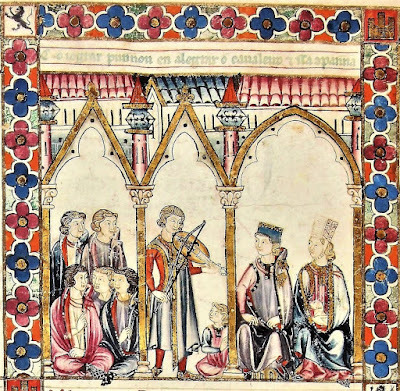 A good troubadour in Cantiga 194, T codex.
A good troubadour in Cantiga 194, T codex. Cantiga 194 gives Our Lady's Troubadour its title.
RB. Patrimonio Nacional.
With music, poems, and pictures, the Cantigas de Santa Maria are still a true multimedia experience. The music was the most enigmatic aspect for a long time, but since the code was unlocked in the early twentieth century, musicians have leapt at the chance to re-create the sounds of Alfonso X's court.
A major reason Alfonso X is considered “the wise king” is because he placed himself at the center of the constant exchange of hybrid cultural currents of his era. He fostered an avid interest in the both the sciences and the arts and was obsessed with setting it all down in writing. This mania for compilation led to the Cantigas manuscripts becoming one of the largest songbooks of medieval Europe, with musical notation for more than 400 songs.
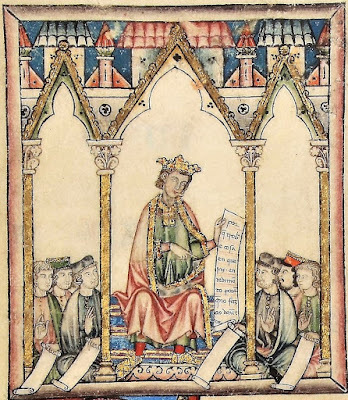 Alfonso holds up the musical prologue in the T
Alfonso holds up the musical prologue in the Tmanuscript of the Cantigas. RB. Patrimonio Nacional.
I’ve studied the Cantigas de Santa Maria, mostly as literature, for more than twenty years, and I’m accustomed to English-speaking people having some strange preconceptions about this marvel of the Middle Ages. Now that I live in Spain, where the people ought to have these rhythms in their blood, I thought I might be able to skip the introductory lecture on what the Cantigasare really like.
I was wrong. My wonderful musician friends who are helping me put together some cantigas for my book launch in December made the same assumption non-Spaniards have made in the past. Since the stories tell the miracles of the Virgin Mary, they think the melodies are going to be droning, stultifying church music heavily influenced by the apparent shapelessness of Gregorian chant.
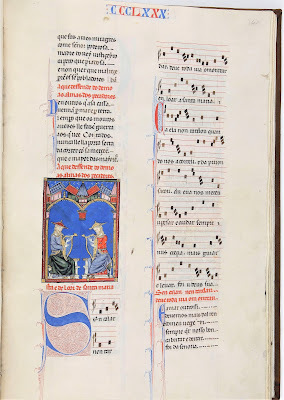 Cantiga 380 (E manuscript) with exotic hats and written music.
Cantiga 380 (E manuscript) with exotic hats and written music.RB. Patrimonio Nacional.
Now, I don’t consider Gregorian chant to be boring, but it’s true it never captured my imagination the way the Cantigas have, with their virtuosic earworms and lively rhythms. Although the Cantigas have a single line of text and music, this doesn’t reflect the influence of church music, which at the time was largely polyphonic. Here, monophony is a way to avoid obscuring the words and the meaning of the stories.
It’s important to remember that this music was written by the best troubadours at the most sophisticated moment of their age, and in some cases by the cosmopolitan king himself. It was meant to be heard at court, possibly accompanied by dance or even some type of drama. The story was all-important. The Cantigas’ music is more like the movies, singer-songwriters, folk music, and even marching bands of their time than like something a monk would sing.
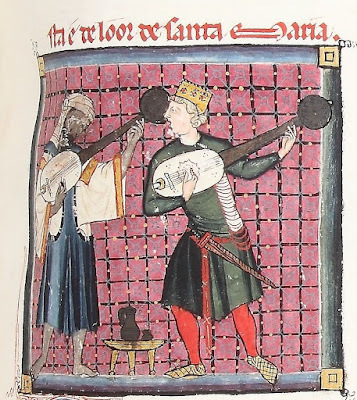 This illustration for Cantiga 130 from the E manuscript
This illustration for Cantiga 130 from the E manuscript shows a multicultural environment. RB. Patrimonio Nacional.
Additionally, the Castilian court likely welcomed the influence of the Andalusians or Moors, who brought the latest innovations in instruments and theory to the Iberian Peninsula. Although no one has discovered a manuscript describing the style with which Alfonso wanted the Cantigasto be played, the melodies, the stories, and even the miniatures point clearly to Muslim musicians, who were, culturally, the posh kids of the time everyone wanted to imitate.
These seemingly opposite currents of northern troubadours and southern musicians, and ostensibly religious themes in a secular court setting, came together to create what I consider some of the most beautiful and just plain fun music in the world.
I leave you with a version of Cantiga 166, which features in the introduction of Our Lady's Troubadour, because when I heard it for the first time, it changed my life.
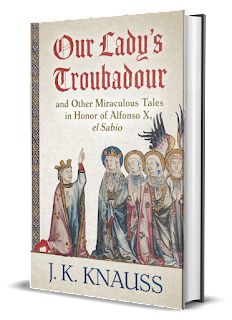
Our Lady's Troubadour lets you experience this rich world in a fun new way with ten exciting stories!
November 17, 2021
Alfonso X's Greatest Work on His 800th Birthday
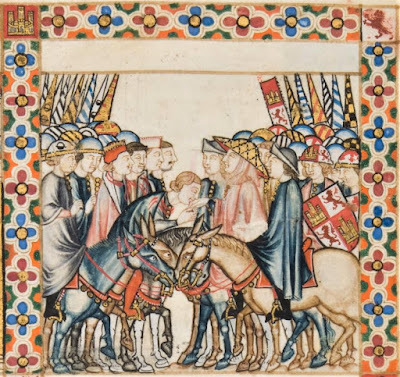 This illustration of Cantiga 235 in the F manuscript of the Cantigas
This illustration of Cantiga 235 in the F manuscript of the Cantigasshows Alfonso X meeting a diplomatic retinue during his travels to meet with
the Pope in Beaucaire in 1275. The trip ended in disappointment, and
much worse was soon to come...
The historical figure of Alfonso X, el Sabio, has accompanied me through travels, trials, and tribulations for most of my life. As a human being, he was probably as complex and hard to live with as anyone, but I will always love what he stands for now: thirst for knowledge and the application of that knowledge to live better and improve the world.
I've written about Alfonso X many times. Perhaps most important is his contribution to world culture. It gives some indication why I feel such tremendous respect for this king and scholar.
Our Lady's Troubadour, which came out yesterday, celebrates Alfonso's 800th birthday on November 23, 2021, by adapting ten of the plots of the Cantigas de Santa Maria so modern readers can easily enjoy them and understand something of Alfonso X's world.
The Cantigas de Santa Maria are one of the medieval compilations of miracles of the Virgin Mary. This collection is unique because:
the miracles are told in the form of song;
it’s a very large collection, with more than 400 of these songs, including every musical style in the Europe of their time;
the manuscripts themselves are unique;
the way the songs are organized has no equal;
and most importantly, the Cantigas de Santa Maria are unique because of the personal involvement of the king.
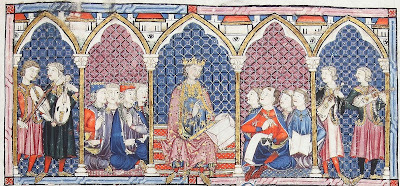 Alfonso X's court in the presentation miniature of the E manuscript.
Alfonso X's court in the presentation miniature of the E manuscript. RB. Patrimonio Nacional.
Here we see the king, Alfonso X himself, in the center of this illustration of his court from the first pages of the E codex. On the sides we have musicians tuning up, noblemen seated on pillows ready to listen, and tonsured monks ready to take dictation. Gold leaf, bright colors, happy feet jutting over the border, and blissful expressions complete a dynamic portrait of the royal workshop. The king's centrality in this picture is not casual: this is one of many ways Alfonso put his personal signature on the Cantigas. He wanted future generations to know that this wonderful book came about because of him.
As we read the different miracles in the Cantigas, we witness all levels of daily life as well as extraordinary times. We spend time with people who have nothing to eat or are ill as well as with princes and an empress.
 For an introduction to how wonderful the Cantigas de Santa Maria are with examples, read here.
For an introduction to how wonderful the Cantigas de Santa Maria are with examples, read here. For a more thorough but no less enthusiastic introduction to the Cantigas, read the introduction to Our Lady's Troubadour.
For an even more thorough, documented, and scholarly approach to what the Cantigas are (where you'll still note unadulterated joy shining through), read the second chapter of Law and Order in Medieval Spain.
I'll write more about the wide variety of topics to explore in the Cantigas in the weeks and months to come. It's going to be a fun ride!
I'll end this strange introduction to an extraordinary king and his favorite book with my take on Cantiga 295.
Cantigas 295 is one the happiest of the Cantigas de Santa Maria. In it, some nuns the king himself brought in to worship a certain image of St. Mary have a vision of St. Mary herself calling for the king. When he comes to lay prostrate before her, saying he would kiss her hands and feet in devotion, St. Mary says no, she wants to kiss his hands because of all the great things he does in her honor. A dream come true for Alfonso X!
This is me singing unaccompanied, and yes, there are mistakes. But I hope you can hear the joy with which I share this music with you! Thanks for listening.
November 4, 2021
I'm Not a Performing Artist
 Tryna do it like I seen 'em do it over on the UToob
Tryna do it like I seen 'em do it over on the UToobMy big, amazing idea to break through with lots of sales of my latest book (which happens to be intensely important to me because it commemorates 800 years of my man, Alfonso X) was to do a series of videos, which would naturally go viral.
Largely due to the sweeping cultural changes of 2020, I've become much more aware of the power of sites like YouTube. I have a unique voice and can talk on subjects that are interesting to at least a few people, so videos seemed like something I should do.
I wanted a video introducing the Cantigas de Santa Maria, why they're awesome, and why I wrote a book using some of the stories from them at this moment in time. Then I would have at least one video for each of the stories in Our Lady's Troubadour explaining where the miracle came from, cool details about where it takes place and/or its illustrations in the manuscripts, and the melody of at least one verse and chorus, sung by yours truly.
Ideally, these videos would've been released throughout 2021 and built up tons of excitement for Alfonso's 800th birthday, as much excitement as I already feel!
But here we are in November, and not a single video has been made.
Why is this? I'm not lazy, not a procrastinator. Ask anyone who knows me, who went to school with me, or worked with me: I never miss a deadline.
Answer that may seem like an excuse: I'm a widow, and if I don't work (at my editing business) and meet my deadlines, nobody (me) eats. It feels counterproductive to pour time into my day job when what I want is for my writing career to take off. That's the suffering of artists in our time.
Of course I manage to make some time to forward my writing career, so the question remains--not a single video?
Every time I sat down to put together the graphics and think about what I was going to say, I got overwhelmed, and then the slightest thing would distract me. Me, the Great Concentrator. I can concentrate long enough to edit a 200,000-word book that seems to have been written by a drunk fifth-grader (I don't think that about all my editing clients, not by far), but I can't spend a few hours to make a ten-minute video about one of the things I love most in the world?
It's finally dawned on me that unlike the troubadours at the court of Alfonso X, I'm not a performing artist.
Surprisingly to this lifelong wordsmith, making videos is not my forte. I bought a microphone and have loads of strategies for making the best of my strange lighting situation. And then the cat starts to meowl. Or the construction project two houses down makes a racket. And then I have to get ready to go to choir practice.
I'm not great at conversation. Never have been. When it comes to speaking on camera, I'm only really comfortable when I know exactly what to say. I can't seem to sustain a coherent structure on the fly. But who can memorize a script these days? And reading on camera looks terrible. So I'm left with few choices. See the video below if you're curious about what I mean.
I can barely keep it together for one minute. Plus my voice sounds weird. And perhaps that wasn't the best lighting solution, after all. This is as far as I got before my grand epiphany that the video project is too much at this moment in time, and I'll be happier if I switch to something else.
What else?
Kind of obviously, my forte is the written word. Always has been. Whenever a professor "generously" "let" students do presentations instead of writing a final paper, I never took them up on the offer. A presentation, easier than a paper? What planet are they on? Not the same one I am.
That goes in the other direction, too. I'm much likelier to enjoy, understand, and retain something if I've read it as opposed to hearing it.
So I'm going to do the same series as blog posts. They'll be fun for me to write, and informative and hopefully joyful for you to read. They'll include video snippets and lots of pretty pictures.
I realize blogs are antique in 2021, and that videos are the wave of the present, and hopefully the future, because I wouldn't honestly look forward to that marvel my brother and I mentioned many times, smellavision.
But after all, Our Lady's Troubadour is historical fiction, so I'm going to support its release with this historical medium. If you want to read historical fiction, maybe you want to read blog posts, too...?
If I had a lot more free time to tweak the technology and write and remember scripts, a video project might seem doable again. So if you see more videos from me, they're either quite short and manageable, or my life circumstances have changed for the better!
October 13, 2021
2021's Most Commemorative Preorder! Our Lady's Troubadour
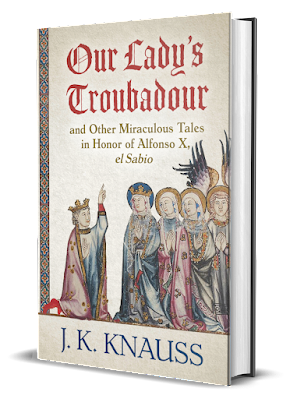
On November 23, 1221, 800 years ago, a baby boy was born in Toledo, Spain. He would go on to become King Alfonso X, el Sabio. He earned his wise reputation because he enthusiastically sought out knowledge wherever it could be found: in Europe, Africa, or Asia; with Christians, Jews, or Muslims. Attracting the top scholars of his time (a very sophisticated time!) to his court, Alfonso was the patron of works of science, literature, history, and law that have influenced scientists, authors, and lawyers for hundreds of years.
This open-minded embracing of different cultures for the betterment of humanity should be celebrated now more than ever. I'm doing just that with Our Lady's Troubadour. It's a book of ten short stories based on Alfonso's greatest work, the Cantigas de Santa Maria. The stories tell of people just like you and me dealing with relatable problems--and finding miraculous solutions.
I'm so excited to see Our Lady's Troubadour out in the world! It will debut on November 17, 2021. November 17 was my husband's birthday. I'm so pleased to be able to honor two of the most important men in my life with one book!
It's ready for preorder now, so you can be sure to have it in time to commemorate November 23. One ebook venue is here, and many sources for the paperback and hardback editions can be found here.
The Spanish edition will be available on the same day!
Happy 800th birthday, Alfonso!
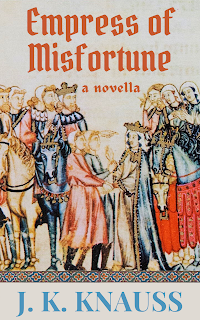
And grab your copy of the extraordinarily entertaining companion volume, Empress of Misfortune:
- available for 99 cents at select outlets
- or FREE to my email subscribers

In still historical, but not medieval, news:
For October, I've gotten into the spirit of scary (the melancholic, Edgar Allan Poe kind) with a story based on the poem "The Lake." It's free to read on Vocal, and in fact, if you scroll to the bottom, you're really helping me out. Thanks!
October 4, 2021
Empress of Misfortune, a Big Little Novella, Out Now!
I've been working on a very special story that's so big, it outgrew the confines of forthcoming Our Lady's Troubadour.
 It started as a short story for Our Lady's Troubadour, but there was just so much to tell, it became a novelette, and now I'd like to share this brand-new, imaginative historical novella, Empress of Misfortune, with you.
It started as a short story for Our Lady's Troubadour, but there was just so much to tell, it became a novelette, and now I'd like to share this brand-new, imaginative historical novella, Empress of Misfortune, with you.
Description:
In an Ancient Rome that never was, Empress Beatriz is surrounded by loyal subjects and the emperor, who cherishes her above all else. Due to one man’s lust and greed, she must fight, alone, for her dignity—and her life.
The primeval tale of the valiant empress has been adapted from Cantiga 5 of the thirteenth-century Spanish Cantigas de Santa Maria. Though this volume stands alone, it is also a companion to the ten short stories in Our Lady’s Troubadour (Encircle Publications, 2021).
Between fantasy and history, this thrilling novella takes us on an imaginary tour of the ancient Mediterranean and inspires us to rely on our own best nature.
Includes two deluxe color illustrations from the Códice rico of the Cantigas de Santa Maria.
Get Empress of Misfortune:
99 cents at select outlets
Or sign up for my author newsletter and read this heart wrenching tale for free!
Excerpt
“Beatriz stood with her hands out and faced the wind, daring it to knock her into the water. A scream had been building inside her for years, since the moment Felix had laid his hands on her. It had gained power when Antoninus sent her to die without a second thought, when she lost the chance to see her children ever again, when Rufus embraced her, and especially when that miscreant robbed the world of little Evander. It stood back when the captain treated her humanely, and she hoped for a simple life in the East. But now that every person she’d ever cared for, every possibility for peace she’d ever come upon, and every hope she’d ever held to had been mercilessly taken from her, the scream pressed on her heart and clawed at her throat.
“She loosed it to the winds. No one heard it but St. Mary.” –from Chapter VI
Early Review
“Empress of Misfortune reads as part fairy tale, part hagiography. It’s about piety but also about a woman taking charge of her destiny. The reader can’t help but like Beatriz and really want the villains to get their just deserts. The chapters end in a suspenseful way and make this reader want to turn the page.” —author Kim Rendfeld
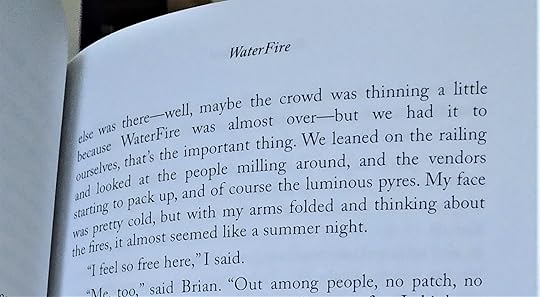
In other news, Kindle Press has decided to give everyone a chance to experience Providence's most mystical tradition, WaterFire, in October, just like the characters in Awash in Talent! October 5 - 11, Awash in Talent is only 99 cents in Kindle! Walk along the river, admiring the luminous pyres right along with Kelly and Brian, without having to travel.
Great things are still to come in 2021!
September 11, 2021
Enlarging the Family: Tree/House and Unpredictable Worlds Now Available in Portuguese
It is my great pleasure to announce the ebook release of Casa na Árvore and Mundos Imprevisíveis, two of my most imaginative books, in Portuguese!

My writing is heavily influenced by magical realism, which is an important literary trend all over Latin America. So I'm thrilled that Tree/House and Unpredictable Worlds are now available in the two dominant languages of Latin America, Spanish and now beautiful, poetic Portuguese.
I've done 500 days of Duolingo in Portuguese and taken a fantastic trip through northern Portugal with a Spaniard. My skills in this marvelous language leave something to be desired.
But they've been translated by two up-and-coming translators, and I trust that these stories are just as complex and thought-provoking in Portuguese.
More information about Casa na Árvore here.
More information about Mundos Imprevisíveis here.
July 28, 2021
Burning Questions about The Atwells Avenue Anomaly Answered
The Atwells Avenue Anomaly is a short science fantasy read that really gets people talking! In this video, I answer a few reader comments about my new release.
You'll hear about a portal to another universe, see a couple of beautiful illustrations, and dream about an infinite library!
July 20, 2021
Amazing Book Debuts in Three Languages to Honor the Most Bookish King in the Year of His 800th Birthday with Cover Reveals
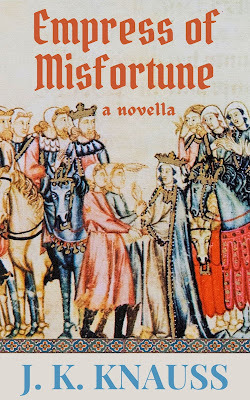
November 23, 2021, marks eight hundred years since King Alfonso X, el Sabio, came into the world. He earned his sobriquet, which means "the Wise," or "the Learned," by encouraging scientific developments that influenced astronomers for centuries, and setting his workshop to writing histories and the incomparably wonderful Cantigas de Santa Maria , among other projects.
In addition to the ten happy, miraculous stories in Our Lady's Troubadour , I'm going to publish a companion volume, a novella based on the plot of Cantiga 5, Empress of Misfortune. The scope of Empress Beatriz's thrilling adventures simply would not fit in with the other stories, so she's going it alone, and will appear this fall shortly before Our Lady's Troubadour.
The cover image, which my newsletter subscribers got a first look at in June, is just a taste of the masterpiece medieval illustrations I'm including with the story.
My newsletter subscribers will have the chance to receive this harrowing tale of resilience and the redemption of innocence for free.
 Las conmemoraciones alfonsinas siguen con la edición de mi libro de crítica literaria en español con el título La ley y el orden en la España medieval. Traducido por un joven promesa, Diego Alejandro Parrilla, este libro investiga el punto de vista del rey a través de las Cantigas de Santa María y su obra legislativa para pasar un rato en el mundo idealizado que el rey deseaba que fuera la Castilla del siglo XIII.
Las conmemoraciones alfonsinas siguen con la edición de mi libro de crítica literaria en español con el título La ley y el orden en la España medieval. Traducido por un joven promesa, Diego Alejandro Parrilla, este libro investiga el punto de vista del rey a través de las Cantigas de Santa María y su obra legislativa para pasar un rato en el mundo idealizado que el rey deseaba que fuera la Castilla del siglo XIII.
(The celebrations of Alfonso X continue with the well-timed appearance of my nonfiction examination of his worldview, Law and Order in Medieval Spain, in Spanish as La ley y el orden en la España medieval.)
"That's still only two languages," you say.
Never fear, the third comes with the spectacular news that Seven Noble Knights is being released in Italian from Vintage Editores. I don't speak Italian, but if that's your reading language of choice, an epic story of family, love, and revenge in the exotic locations of medieval Spain await you! It will be available in September, which feels right because Settembre = Sette nobili cavalieri.
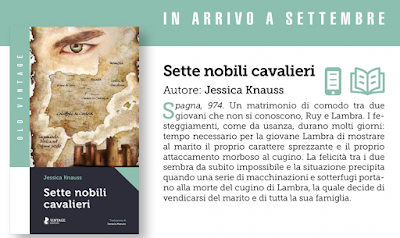
As you know, Seven Noble Knights is based on texts found in Alfonso X's history book Estoria de Espanna. My 2021 is all about Alfonso X! Eight hundred years of studiousness, baby!



